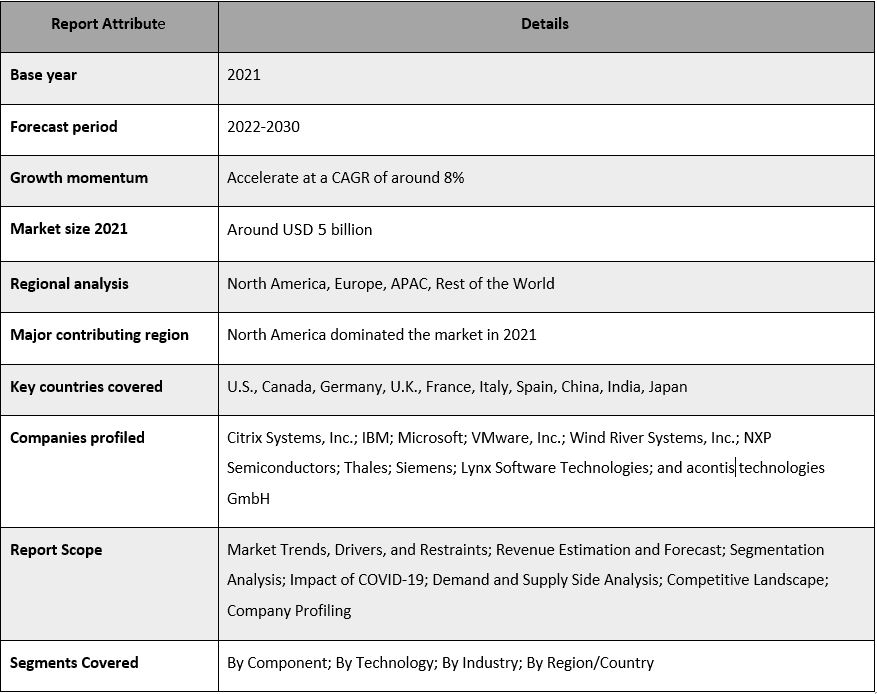- Home
- About Us
- Industry
- Services
- Reading
- Contact Us
Embedded Hypervisor Market: Current Analysis and Forecast (2022-2030)
Emphasis on Component (Software and Services); Technology (Desktop Virtualization, Server Virtualization, and Data Center Virtualization); Industry (Information & Communication Technology, Banking & Financial Services, Aerospace & Defense, Healthcare, and Others); and Region/Country

The Embedded Hypervisor Market stood at around 5 billion in 2021 It is projected to grow at a CAGR of 8.0% by 2030 owing to the rising demand for multi-core embedded systems. An embedded hypervisor is a type of software that enables the simultaneous operation of multiple computing environments on a single system on a chip (SoC). It offers system designers the ability to merge various operating systems (OSs) and applications that have different reliability, safety, and security needs onto a single SoC. Additionally, it ensures quick startup times and real-time performance while allowing for the incorporation of features that are more easily implemented by a specific operating system, such as multimedia applications running on Android. Furthermore, it enhances reliability through system monitoring, detecting failures in individual computing environments, initiating shutdown procedures, and automatically restarting the affected environment without impacting the hypervisor or other running environments. Moreover, the surging demand for data security in businesses and technological advancements are other factors helping the market to grow. Additionally, the growing adoption of cloud computing in various industries is one of the most prominent factors contributing to the growth of the market. For instance, according to Google Cloud, by 2027, more than 50% of enterprises will use industry cloud platforms to accelerate their business initiatives.
Some of the major players operating in the market are Citrix Systems, Inc.; IBM; Microsoft; VMware, Inc.; Wind River Systems, Inc.; NXP Semiconductors; Thales; Siemens; Lynx Software Technologies; and acontis technologies GmbH. Several M&As along with partnerships have been undertaken by these players to facilitate customers with hi-tech and innovative products/technologies.
Insights Presented in the Report
“Amongst component, the software catered to a significant share of the market in 2021”
Based on component, the market is bifurcated into software and services. The software segment catered to a significant share of the market in 2021 owing to the increasing demand for embedded hypervisor software is driven by the need for system consolidation, real-time operation, mixed-criticality support, legacy system migration, security, and improved software development and testing capabilities in the embedded systems domain.
“Amongst technology, the desktop virtualization segment catered to a significant share of the global embedded hypervisor market in 2021”
On the basis of technology, the market is classified into desktop virtualization, server virtualization, and data center virtualization. Among these, the desktop virtualization segment catered to a significant share of the global embedded hypervisor market in 2021. The need for flexible and mobile work environments, enhanced security and data protection, cost savings and simplified IT management, improved disaster recovery capabilities, and support for diverse devices and operating systems are the major factors that contributed to the growth of this segment. These benefits make desktop virtualization an attractive solution for organizations aiming to boost productivity, increase data security, and streamline IT operations.
“North America held a significant share of the global embedded hypervisor market in 2021”
North America held a significant share of the global embedded hypervisor market in 2021. The rising need for efficient and flexible solutions in complex embedded systems, the expansion of the IoT ecosystem, the focus on safety and reliability in critical industries, and the advantages of flexibility and scalability offered by hypervisor technology are some of the most prominent factors contributing to the growth of the market in the region. As embedded systems continue to evolve and become more sophisticated, embedded hypervisors are expected to play an increasingly vital role in meeting the demands of these advanced applications.
Embedded Hypervisor Market Report Coverage

Reasons to buy this report:
- The study includes market sizing and forecasting analysis validated by authenticated key industry experts.
- The report presents a quick review of overall industry performance at one glance.
- The report covers an in-depth analysis of prominent industry peers with a primary focus on key business financials, product portfolios, expansion strategies, and recent developments.
- Detailed examination of drivers, restraints, key trends, and opportunities prevailing in the industry.
- The study comprehensively covers the market across different segments.
- Deep dive regional level analysis of the industry.
Customization Options:
The global embedded hypervisor market can further be customized as per the requirement or any other market segment. Besides this, UMI understands that you may have your own business needs, hence feel free to connect with us to get a report that completely suits your requirements.
Table of Content
Research Methodology for the Embedded Hypervisor Market Analysis (2022-2030)
Analyzing the historical market, estimating the current market, and forecasting the future market of the global embedded hypervisor market were the three major steps undertaken to create and analyze the adoption of embedded hypervisors in major regions globally. Exhaustive secondary research was conducted to collect the historical market numbers and estimate the current market size. Secondly, to validate these insights, numerous findings and assumptions were taken into consideration. Moreover, exhaustive primary interviews were also conducted, with industry experts across the value chain of the global embedded hypervisor market. Post assumption and validation of market numbers through primary interviews, we employed a top-down/bottom-up approach to forecasting the complete market size. Thereafter, market breakdown and data triangulation methods were adopted to estimate and analyze the market size of segments and sub-segments of the industry pertains to. Detailed methodology is explained below:
Analysis of Historical Market Size
Step 1: In-Depth Study of Secondary Sources:
Detail secondary study was conducted to obtain the historical market size of the embedded hypervisor market through company internal sources such as annual reports & financial statements, performance presentations, press releases, etc., and external sources including journals, news & articles, government publications, competitor publications, sector reports, third-party database, and other credible publications.
Step 2: Market Segmentation:
after obtaining the historical market size of the embedded hypervisor market, we conducted a detailed secondary analysis to gather historical market insights and share for different segments & sub-segments for major regions. Major segments are included in the report as component, technology, and industry. Further country-level analyses were conducted to evaluate the overall adoption of testing models in that region.
Step 3: Factor Analysis:
After acquiring the historical market size of different segments and sub-segments, we conducted a detailed factor analysis to estimate the current market size of the embedded hypervisor market. Further, we conducted factor analysis using dependent and independent variables such as component, technology, and industry of the embedded hypervisor market. A thorough analysis was conducted for demand and supply-side scenarios considering top partnerships, mergers and acquisitions, business expansion, and product launches in the embedded hypervisor market sector across the globe.
Current Market Size Estimate & Forecast
Current Market Sizing: Based on actionable insights from the above 3 steps, we arrived at the current market size, key players in the global embedded hypervisor market, and market shares of the segments. All the required percentage shares split, and market breakdowns were determined using the above-mentioned secondary approach and were verified through primary interviews.
Estimation & Forecasting: For market estimation and forecast, weights were assigned to different factors including drivers & trends, restraints, and opportunities available for the stakeholders. After analyzing these factors, relevant forecasting techniques i.e., the top-down/bottom-up approach were applied to arrive at the market forecast for 2030 for different segments and sub-segments across the major markets globally. The research methodology adopted to estimate the market size encompasses:
- The industry’s market size, in terms of revenue (USD) and the adoption rate of the embedded hypervisor market across the major markets domestically
- All percentage shares, splits, and breakdowns of market segments and sub-segments
- Key players in the global embedded hypervisor market in terms of products offered. Also, the growth strategies adopted by these players to compete in the fast-growing market
Market Size and Share Validation
Primary Research: In-depth interviews were conducted with the Key Opinion Leaders (KOLs) including Top Level Executives (CXO/VPs, Sales Head, Marketing Head, Operational Head, Regional Head, Country Head, etc.) across major regions. Primary research findings were then summarized, and statistical analysis was performed to prove the stated hypothesis. Inputs from primary research were consolidated with secondary findings, hence turning information into actionable insights.
Split of Primary Participants in Different Regions

Market Engineering
The data triangulation technique was employed to complete the overall market estimation and to arrive at precise statistical numbers for each segment and sub-segment of the global embedded hypervisor market. Data was split into several segments & sub-segments post studying various parameters and trends in the areas of the component, technology, and industry in the global embedded hypervisor market.
The main Objective of the Global Embedded Hypervisor Market Study
The current & future market trends of the global embedded hypervisor market were pinpointed in the study. Investors can gain strategic insights to base their discretion for investments on the qualitative and quantitative analysis performed in the study. Current and future market trends determined the overall attractiveness of the market at a regional level, providing a platform for the industrial participant to exploit the untapped market to benefit from a first-mover advantage. Other quantitative goals of the studies include:
- Analyze the current and forecast market size of the embedded hypervisor market in terms of value (USD). Also, analyze the current and forecast market size of different segments and sub-segments
- Segments in the study include areas of the component, technology, and industry
- Define and analysis of the regulatory framework for the embedded hypervisor industry
- Analyze the value chain involved with the presence of various intermediaries, along with analyzing customer and competitor behaviors of the industry
- Analyze the current and forecast market size of the embedded hypervisor market for the major region
- Major countries of regions studied in the report include Asia Pacific, Europe, North America, and the Rest of the World
- Company profiles of the embedded hypervisor market and the growth strategies adopted by the market players to sustain in the fast-growing market
- Deep dive regional level analysis of the industry
Related Reports
Customers who bought this item also bought










